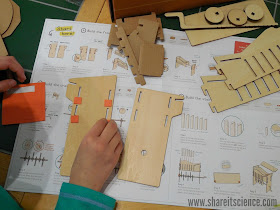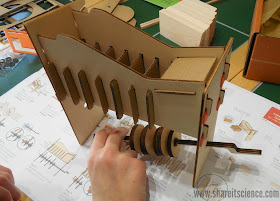Tinker Crate is a subscription service that sends out cool hands-on STEM projects aimed at kids aged 9-16+ each month. Each box contains the blueprint for the project, Tinkerzine a magazine with additional STEM activities and science experiments, special links to online tutorials and all the materials needed to create an awesome STEM project.
The automaton engineering project in this box was fun to build and reminded us a bit of an escalator. The extension DIY projects included in the magazine were engaging and extended the building and learning experience. Read on to find out how we built it and more about Tinker Crate!
This post contains affiliate links, meaning I receive a small commission on purchases made through these links. Please see disclosures for more information.
Inside the Tinker Crate Automaton Box
One of the things I love about Tinker Crate is that everything you need truly does come right in the box. Whether you are looking for a project to do alongside your child, or one that they can build on their own, you've got all the materials and directions necessary for success.It's fun to subscribe and get a new project each month, however if you'd like to try just this project yourself, you can purchase single boxes too.
In addition to the project itself, the Tinkerzine magazine included an explanation and the history of the automaton, ideas and supplies for additional projects, and related book suggestions. All of this definitely extends the life of this project and engages kids to immerse themselves in the topic, in this case, automatons.
Kids who are fans of the movie, Hugo, will remember the automaton, or human-like mechanical device, that played a big role in the story. The Tinkerzine in this box suggests the book, The Invention of Hugo Cabret, by Brian Selznick which also follows this story.

Building the Automaton
The blueprint for the automaton project was designed with all learning styles in mind. The directions were written in words and described in pictures as well. Kids on the younger end of the suggested age for these projects, might need a bit of help, but for ages 12 and up it seemed very manageable to complete independently.Although the project directions are mapped out, it was still necessary to use the engineering process to work through how to complete the automaton. Several steps were a little tricky, so it took some trial and error before the automaton lifted the balls properly. Each time we were able to make an adjustment and test it again to see how to fix the issue.
Seeing how this machine worked and going through the building process really illuminated how other machines might work too. Completing a project like this definitely has real-world applications as it gets you thinking about how things work. It's hard not to imagine reverse-engineering a gadget once you complete the engineering thought process.
The completed automaton!
Extension Projects
We loved that the Tinker Crate box included several ideas for extension activities and supplied what you needed to do them. There was very little waste, you even use the box to build extras. The ideas continued to get us thinking about building different spinning and moving machines. |
| Even cats love Tinker Crate! |
We're excited to try building more mechanical creations with the Tinkerzine suggested book: Karakuri: How to Make Mechanical Models that Move.

If you'd like to see what other examples of Tinker Crate and the rest of the Kiwi Crate brand of subscription boxes look like, check out this video by clicking here.
Looking for more engineering projects? Try these nature sculpture engineering challenges! You might also enjoy 100 Engineering Projects for Kids.
We think Tinker Crate would be an awesome gift to give kids who love to build, experiment and explore. You can order monthly subscriptions, or buy single boxes.
Disclaimer: I was not compensated by Tinker Crate to write this post. All opinions are my own.











No comments:
Post a Comment